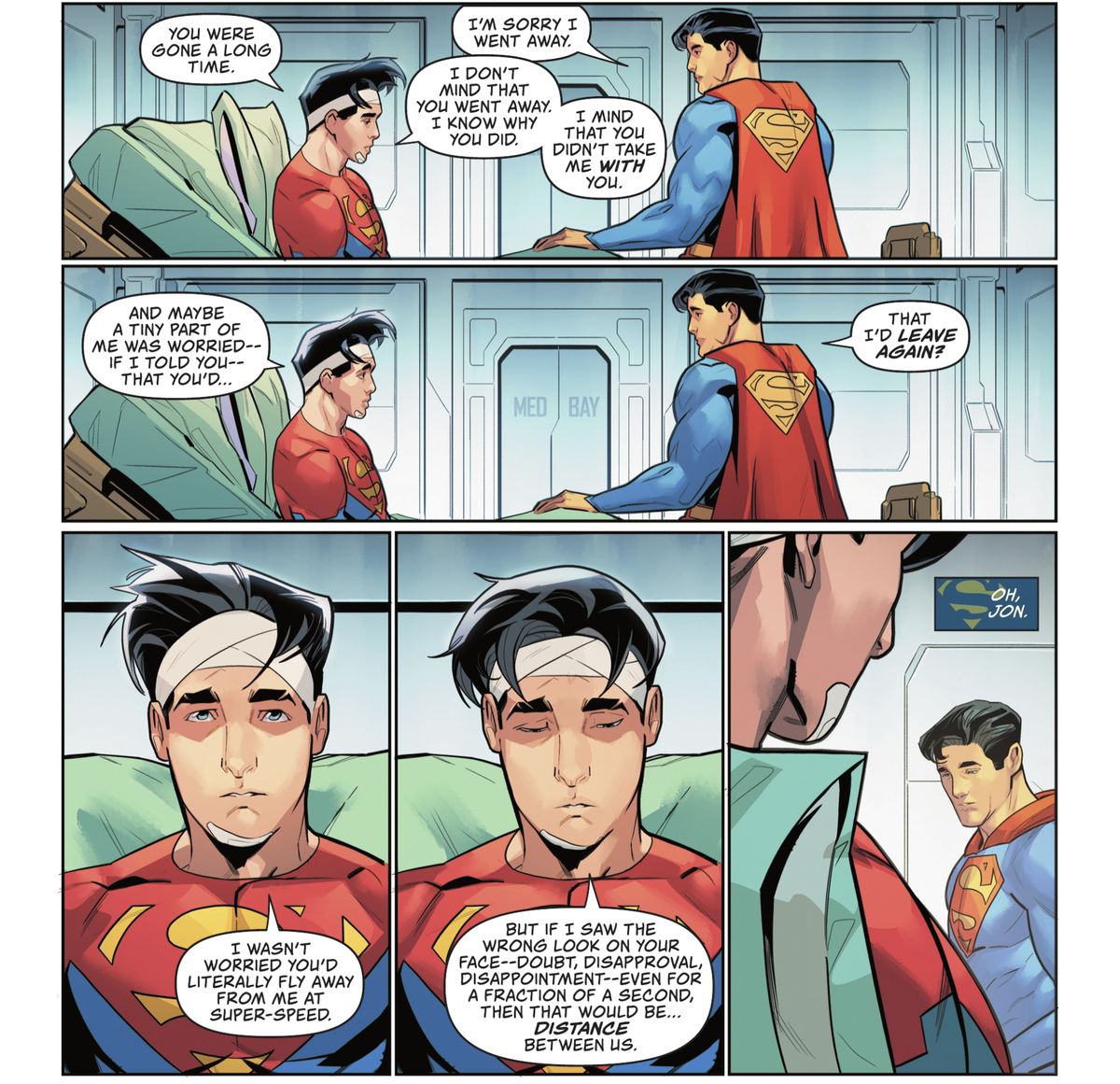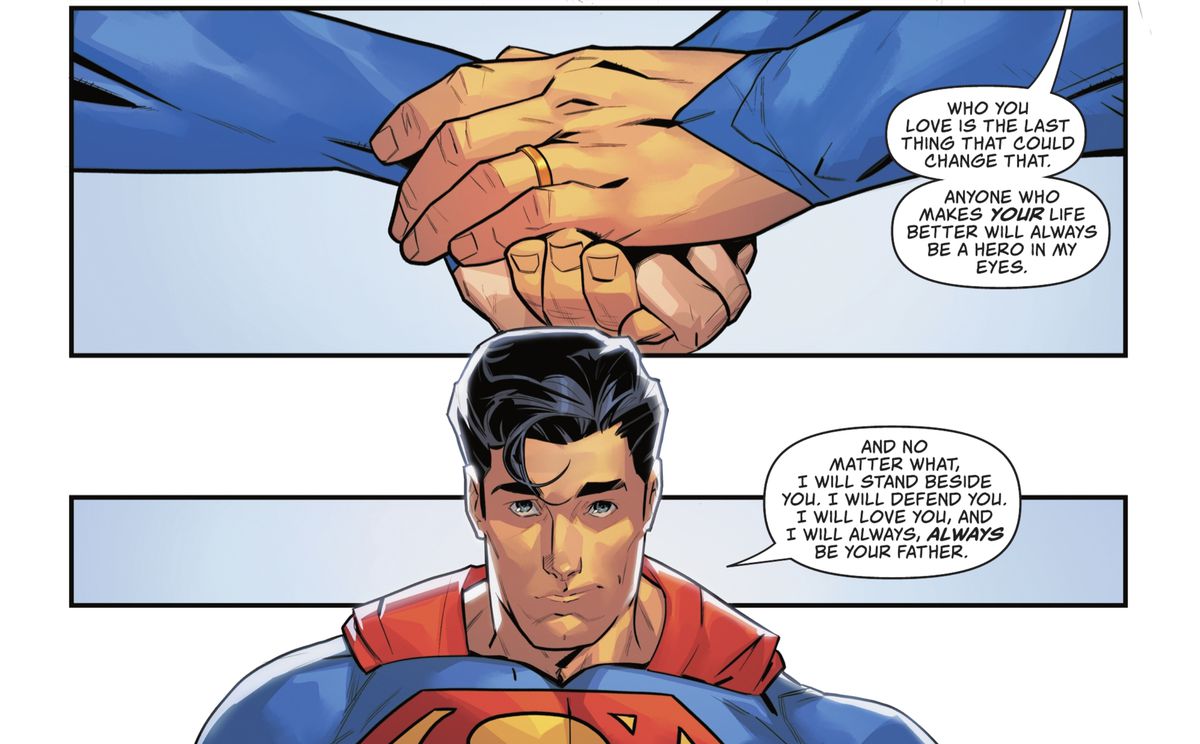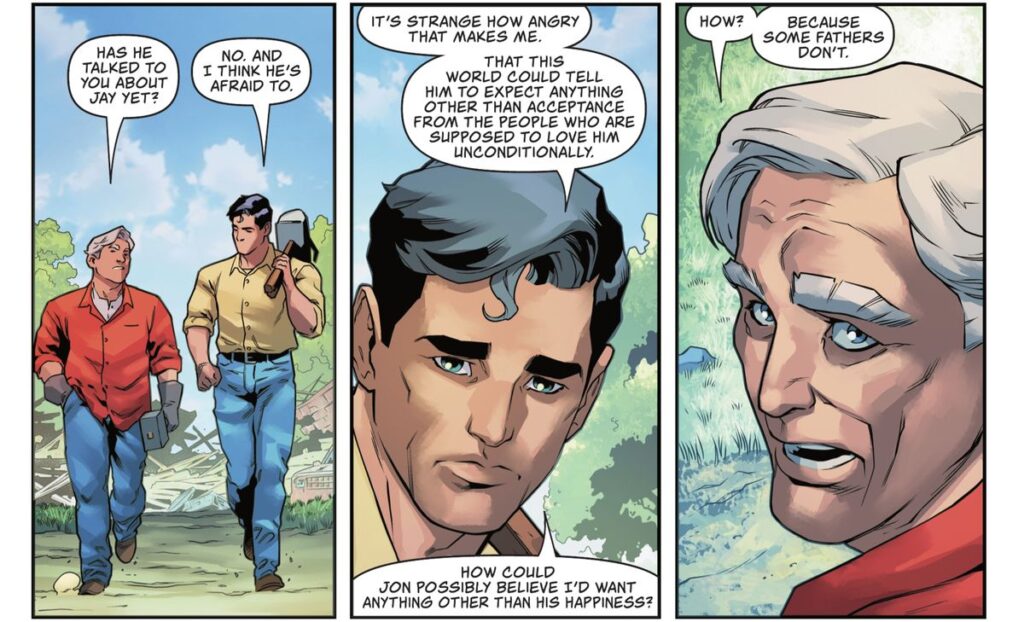Superman’s 2022 hasn’t been like any other year in the life of the world’s first superhero. The Action Comics series has kept Clark Kent busy in space, overthrowing the dictator of a gladiator planet. In the meantime, Earth has been guarded by his son Jon, who has learned a lot about himself since he took up his father’s mantle as Superman, including that he’s bisexual.
But last month, Clark returned victoriously from Warworld, and that means that this month is, logistically, the first moment in which Superman could actually find out, and react to, the fact that his son is queer. The honor and challenge of crafting that moment fell to writer Tom Taylor, artist Cian Tormey, and the rest of the team on Superman: Son of Kal-El.
[Ed. note: This piece will contain spoilers and art from Superman: Son of Kal-El #17.]
The folks behind Son of Kal-El are the creators who established Jon Kent as a queer character last November. So it shouldn’t come as a surprise that Superman accepts his bisexual son in the very book that paired Jon Kent up with a cute underground journalist who can phase through walls.
But that very expectation creates a genuine narrative hole: How do you give a story stakes when the conclusion is so obvious? How do you give a story tension without simply reviving queer trauma before the reader’s eyes? And how do you keep the whole thing from reading as flat as a Very Special Episode?
Speaking to Polygon via email, Taylor says it was a challenge that he solved with one key change. “For the first time in our series, the inner monologue isn’t Jon’s. The reader experiences this moment of a father’s love with Clark.”
Ever since Superman’s dad-ness became a regular part of the character in main DC Comics continuity, the status has offered creators a built-in lever to flip the Man of Steel from an invulnerable monolith to a vulnerable, relatable guy who’s just trying to raise his son in a crazy world.
And in Son of Kal-El #17, Clark is nothing but vulnerable. It’s not just a father’s love that comes out in the issue, but his fear and anger. Thanks to Jon’s adventures, most of the world knows he has a boyfriend by now, and in his big ol’ steadfast heart, it takes Clark a beat or two to even understand why Jon might hesitate to actually talk to him about it.
Speaking from personal experience, even when you’re a financially independent adult and you’re virtually certain your dad will love and accept you afterward, it’s still scary to come out to your parent! And you may find that seeing your fear made them afraid that they’d failed you. Thanks to the power of fiction, Jon is actually able to articulate why he’d still be scared to come out to the world’s best dad in Son of Kal-El #17 — a superpower I sure wish I’d had.
“The scene with Clark and Jon took me almost as long to write as a whole comic usually would,” Taylor says. “I spent days working and reworking and fine-tuning three pages. Of course the expectation is Superman will instantly accept and welcome his son, but I didn’t want to write a clichéd scene we’d seen many times before, one that didn’t feel earned or real.”

Image: Tom Taylor, Cian Tormey/DC Comcis
It can be difficult to boil down the superhero genre to its basic tenets when nearly a century of experimentation with the form has created an exception to nearly every rule. There are a ton of iconic superheroes who don’t have secret identities, others who don’t wear a costume, and tons who don’t even have superpowers. Some heroes patrol a dark city every night, others the depths of space; some solve mysteries, others turn back natural disasters.
As the superhero from which superhero variation sprang, Superman’s genericness is the archetypal answer to the genre’s 84-year quest to define heroism itself. And there is a phenomenal and necessary power in casting him as a person who unconditionally loves his queer child.
“I definitely felt the importance of showing Superman’s care, assurance and embrace of his bisexual son,” Taylor says. “And I wanted to show that Clark understood and empathized with his son’s apprehension. After it was written, I talked to the artists, Cian Tormey and Ruairí Coleman, about the importance of this issue, and both told me they’d teared up reading the script. Cian and Ruairí both took so much care, and depicted these scenes beautifully. I hope what the Man of Steel feels and how he acts in this issue resonates with other parents of queer children.”

Image: Tom Taylor, Cian Tormey/DC Comics
But it’s likely that the issue will resonate with queer children of all ages. One of the side effects of Superman’s dadification is that he has become even more of a mentor figure, an effect only enhanced in a book like Son of Kal-El that’s usually told from the perspective of his child.
Taylor, Tormey, and every other creative who’s worked on the issue haven’t simply had Clark tell Jon that he’ll always love and defend him — they’ve told every queer reader who picks up the book that Superman will always love and defend them as well.

